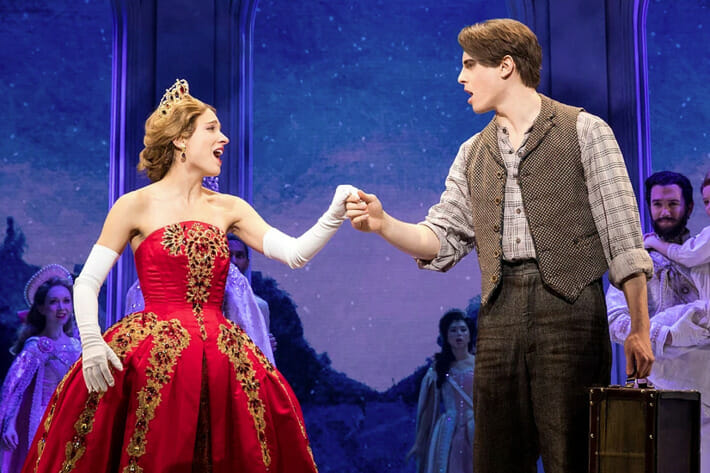Anastasia: 6 Differences Between the Movie and the Broadway Musical
Matthew Murphy/Twentieth Century Fox
Once upon a December, we were waiting in anticipation for the Broadway adaptation of Twentieth Century Fox’s 1997 film Anastasia to open at the Broadhurst Theatre. Now that the show has been officially on since April 24, naturally we need to pick apart the show with a finetooth comb and compare it to its source material. So take a journey to the past, and explore six of the major differences between the animated 1997 feature film Anastasia and its Great White Way interpretation.
1. The Villain
In the animated feature, we are treated with a maniacally mystical Rasputin, voiced by none other than Christopher Lloyd, as the raised-from-the-dead villain out for revenge on the Romanov family, i.e. its remaining member Anastasia. Though barely rooted in any kind of historical realism, his character (along with his endearing bat sidekick, Bartok) add a lot of fun, comic relief and, yes, terror to the film.
In the Broadway production, we are instead presented with a more historically accurate villain in Bolshevik officer Gleb. Gleb represents the communist regime in a post-imperial Russia, and he’s also the son of one of the guards tasked with carrying out the assassination of the entire Romanov family in 1917. It’s through his character that we see the struggles of transition between governments as well as public mentality at this point in history.
2. Focus on Soviet Russia
As mentioned before, there is a lot more focus on the history of the Romanov Empire and its subsequent demise. There is a lot more time focused on what the actual Russian government looks like between the years 1917 and 1927, when this musical takes place, and how its radical changes have affected the mentality of Russia during this time period, and therefore how it would shape our characters’ motivations. For example, when Anastasia, Dmitry and Vlad board a train to Paris to escape the turbulent St. Petersburg (or Leningrad, to root ourselves in history), the train is stopped by Soviet officers to the tragic end of one of its passengers. This veers significantly from the reason Anya and her companions leave the train in the animated movie, which instead featured evil apparitions sent by Rasputin to literally derail the train from the tracks.
-

-

-

-

-

-

-

-

-

-

-

-

-

-

-

-

-

-

-

-

-

-

-

-

-

-

-

-

-

-

-

-

-

-

-

-

-

-

-

-








































